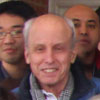Biography
I was born in 1946 in Kingston, Ontario, Canada and attended Kingston Collegiate
and Vocational Institute. In 1964 I began my undergraduate studies
at M.I.T. I spent my junior year (1966-67) in Paris where I took
Math. Un from Laurent Schwartz. I returned to M.I.T. and graduated
in 1968. I went to Berkeley in fall 1968 for graduate school.
It was a memorable experience, a time of great hope and unrest, of people's
park and the Cambodian invasion. I wrote my thesis in 1971
under Jim Simons who was visiting Berkeley for a two week conference.
In it I computed the Chern-Simons invariants of quotients of spheres of
dimension 4k-1. I graduated from Berkeley in 1973
and went to the Institute for Advanced Study at Princeton. After
a year at the Institute I went to Yale as an assistant-professor from 1974
- 1978. While I was at Yale I proved that all the standard arithmetic
examples of hyperbolic n-manifolds admitted finite covers with nonzero
first Betti number. This I consider to be my best work. During
this period I received a Sloan fellowship which I used in fall 1978 at
Oxford then in spring 1978 I went around the world visiting my friends
along the way. The summer of 1978 was momentous to me because I began
two long collaborations. I met my wife Gretchen at the Strawberry
Canyon swimming pool and I began to work with Steve Kudla on the Weil representation
and homology of arithmetic groups. I went to the University of Toronto
in fall 1979 as associate professor, then to UCLA in 1980. Around this
time I began work on the deformation theory of discrete subgroups of Lie
groups and began a long collaboration with Bill Goldman. This subject has
fascinated me ever since and was the subject or my ICM address at Kyoto
in 1990. This was based on work with Bill and was motivated by
a letter from Pierre Deligne (see the publication page of this web page).
In 1989 I moved to the University of Maryland
and began working with Misha Kapovich. Misha and I have written 17 papers
to date. They started with work on configurations spaces of elementary
geometric objects, polygonal linkages in the plane and in space and
arrangements of lines in the projective plane. We gave the first published
proof of theorem first announced by Thurston in the 1990's that, given an compact smooth manifold
M there is a planar linkage whose configuration space is a disjoint union of
a number of copies of M (it is not true that one can get just one copy of M
in general). We later carried over our work to Euclidean buildings where
we found applications to saturation problems for structure constants of representation rings and spherical Hecke algebras associated to reductive algebraic groups defined
over the rational numbers.
The work with Kapovich led me into a four way collaboration with
Ben Howard, Andrew Snowden and Ravi Vakil which resulted in the solution
of a one hundred year old problem in classical invariant theory. In
1894 A. Kempe found generators for the ring of projective invariants of
n ordered points on the projective line (the lowest degree invariants
generate the ring). In his famous book "The Classical Groups" H. Weyl
emphasized the importance of computing both the generators
(First Main Theorem) and relations (Second Main Theorem) for such classical
problems. In 2009, HMSV computed the relations among Kempe's generators,
thereby proving the "Second Main Theorem" for ordered points on the line 115
years after the First Main Theorem was proved.
In 2010 I was asked by S.T. Yau and Lizhen Ji to write an article about
my career for a book honoring Chern's hundredth birthday (Chern was my teacher in
Berkeley) . You can download my article immediately below:
Chern hundredth birthday article
I have been an avid
golfer since my teens and have recently taken up fly-fishing and skiing.

